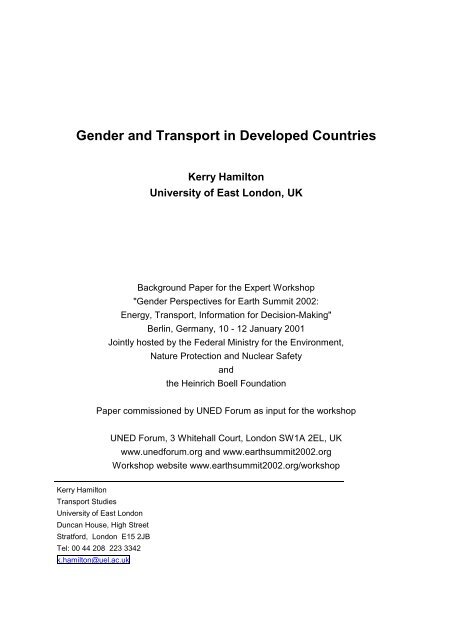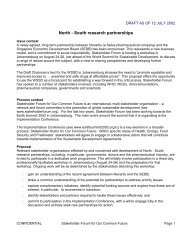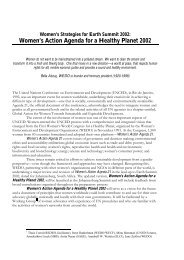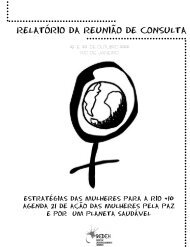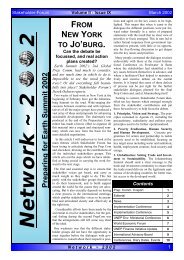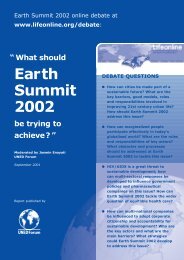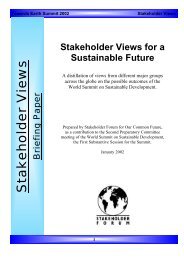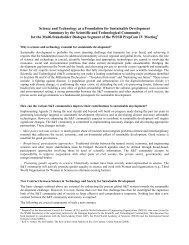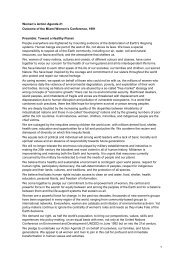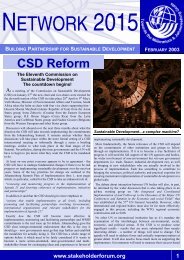How to use the Public Transport Gender Audit Checklist
How to use the Public Transport Gender Audit Checklist
How to use the Public Transport Gender Audit Checklist
You also want an ePaper? Increase the reach of your titles
YUMPU automatically turns print PDFs into web optimized ePapers that Google loves.
<strong>Gender</strong> and <strong>Transport</strong> in Developed CountriesKerry Hamil<strong>to</strong>nUniversity of East London, UKBackground Paper for <strong>the</strong> Expert Workshop"<strong>Gender</strong> Perspectives for Earth Summit 2002:Energy, <strong>Transport</strong>, Information for Decision-Making"Berlin, Germany, 10 - 12 January 2001Jointly hosted by <strong>the</strong> Federal Ministry for <strong>the</strong> Environment,Nature Protection and Nuclear Safetyand<strong>the</strong> Heinrich Boell FoundationPaper commissioned by UNED Forum as input for <strong>the</strong> workshopUNED Forum, 3 Whitehall Court, London SW1A 2EL, UKwww.unedforum.org and www.earthsummit2002.orgWorkshop website www.earthsummit2002.org/workshop_____________________________________________________________________Kerry Hamil<strong>to</strong>n<strong>Transport</strong> StudiesUniversity of East LondonDuncan Ho<strong>use</strong>, High StreetStratford, London E15 2JBTel: 00 44 208 223 3342k.hamil<strong>to</strong>n@uel.ac.uk
IntroductionWe do not believe or assume that all women are <strong>the</strong> same, or that <strong>the</strong>y feel <strong>the</strong> same about publictransport. This is manifestly not so. <strong>How</strong>ever, <strong>the</strong>re are sufficiently significant differences betweenwomen’s transport demands and experiences, as opposed <strong>to</strong> those of men—differences in access <strong>to</strong>private transport, in patterns of commuting and employment, in child-care and elder-care responsibilities,in basic attitudes <strong>to</strong> private and public transport—<strong>to</strong> justify treating women separately. Within thatgroup ‘women’ <strong>the</strong>re are highly important distinctions which depend—for example—upon income, age,ho<strong>use</strong>hold, elder- and child-care responsibilities, ethnicity, employment status, degree of disability,location, class and education The particular balance among <strong>the</strong>se will vary from country <strong>to</strong> country andarea <strong>to</strong> area, and it is <strong>the</strong>refore essential for policy makers and transport opera<strong>to</strong>rs <strong>to</strong> ga<strong>the</strong>r informationlocally in line with best gender balancing practice in order <strong>to</strong> understand <strong>the</strong> characteristics ofwomen.This paper draws on data from Sweden, UK and <strong>the</strong> USA <strong>to</strong> demonstrate <strong>the</strong> widespread nature ofinequality of access for women in <strong>the</strong> developed world and highlight <strong>the</strong> importance of <strong>the</strong> role playedby transport in women’s lives and its potential for ameliorating or exacerbating some of <strong>the</strong> structuraldisadvantages associated with women's roles.Demographic profileThe world's fifth richest economy, <strong>the</strong> UK, has a population of 29.9 million women compared with 28.8million men. Women make up 51% of <strong>the</strong> population. <strong>How</strong>ever, men outnumber women until <strong>the</strong>yreach <strong>the</strong>ir mid-forties, when <strong>the</strong> numbers become more or less equal. For those aged 85 and over,<strong>the</strong>re are 3 women <strong>to</strong> every man. 56% of women in Britain are married; 5% are cohabiting; 18% aresingle; 14% are widowed; 6% are divorced and 2% are separated. Over two fifths (43%) of women ofworking age in <strong>the</strong> UK have dependent children. One in five (21%) of <strong>the</strong>se women is a lone parent. 1In Sweden, 46% of a <strong>to</strong>tal population of over 8 million are women. Figures for 1994, show that 28% of<strong>the</strong> population were living in single adult ho<strong>use</strong>holds and <strong>the</strong> majority of <strong>the</strong> population, some 72%,were cohabiting. Within this group, 39% of <strong>the</strong> population lived in cohabiting ho<strong>use</strong>holds with childrenand 33% lived in cohabiting ho<strong>use</strong>holds without children. Of single person ho<strong>use</strong>holds, 6% had childrenand <strong>the</strong> majority of <strong>the</strong>se were headed by women. 2In <strong>the</strong> US <strong>the</strong> fastest growing ho<strong>use</strong>holds is amongst single parent families. Between 1974-94 <strong>the</strong><strong>to</strong>tal number of US families increased over 17% and <strong>the</strong> number of families headed by a cohabitingmarried couple fell by more than 10%. Families headed by a lone female parent now account for almosta quarter of all American families. Over <strong>the</strong> three decades since 1960 <strong>the</strong> percentage of childrenliving with just one parent tripled. In 1990 around 22% of all children lived in single women ho<strong>use</strong>holds.Women and employmentThe dramatic increase in women in paid employment, especially women with young children, has beenone of <strong>the</strong> most important changes in <strong>the</strong> labour market in <strong>the</strong> post-war era. In <strong>the</strong> UK, <strong>the</strong>re were11.7 million women of working age in employment in 1998/9, yielding an employment rate of 69%(compared with 78% for working age men) 3 . Six out of ten women who were married or cohabitingand who had pre-school children were economically active. In 1997, 44 % of all those of working agein employment were women. Of <strong>the</strong>se, some 44% worked part-time, compared with 8% of men.Women represented 33% of all those working full-time and 88% of all those working part-time.In <strong>the</strong> US, women make up 46% of <strong>the</strong> <strong>to</strong>tal workforce. Since 1970 <strong>the</strong> number of American women inpaid employment increased by over 14% - male employment over <strong>the</strong> same period dropped by 4%. In<strong>the</strong> decade 1980 <strong>to</strong> 1990, almost 14 million women joined <strong>the</strong> workforce, compared <strong>to</strong> just under 10million men. By 1992 over three quarters of women in <strong>the</strong> age group 35-44 were in paid employment.As a result, almost 60% of all women are wage earners. These US figures mask <strong>the</strong> marked increasein <strong>the</strong> workforce by women with children. As Sandra Rosenbloom points out,"In 1986 over 61% of married women with children under 18 worked outside <strong>the</strong> home - compared <strong>to</strong>only 27% in 1960. Just as important is <strong>the</strong> substantial growth of employed married women with very2
young children. In 1960 only 18% of married women with children under 6 were in <strong>the</strong> paid labourforce; <strong>the</strong> comparable number was 30% in 1970 and 33% in 1976. Today almost 60% of marriedwomen with young children have salaried employment while almost 75% of married women with childrenfrom six <strong>to</strong> seventeen are in <strong>the</strong> paid workforce. 4In Sweden, women's participation in <strong>the</strong> workforce has also increased greatly since <strong>the</strong> 1970's and <strong>the</strong>largest increase has been in part-time employment. In 1995 80% of women between 20-64 were in<strong>the</strong> workforce, 45% worked full time and 29% were employed part time 5 .Table 1Distribution of Men and Women by Employment Categories inSweden in 1994, ages 6-84.Private BusinessEmployment StatusWork, full-timeWork, part-timeHome workRetiredStudentWomenMenUnemployed0 5 10 15 20 25 30 35 40 45 50PercentageSource: The 1994 Swedish Travel Pattern Survey quoted in M Polk.The sexual division of labourDespite <strong>the</strong> movement of women in<strong>to</strong> <strong>the</strong> paid employment market, <strong>the</strong> sexual division of labour within<strong>the</strong> ho<strong>use</strong>hold persists. The result has been an expansion of women’s rôles ra<strong>the</strong>r than <strong>the</strong> achievemen<strong>to</strong>f gender rôle equality: any one woman can combine <strong>the</strong> rôles of, for example, paid employee,student, unpaid domestic labourer, and carer of children, sick or elderly people. Women continue <strong>to</strong>be primarily responsible for domestic work, including shopping and child rearing. In 1995 in <strong>the</strong> UK, acomparison of all those aged 16 or over showed that males spent on average 0.42 hours per day ondomestic work compared with <strong>the</strong> average of 2.24 hours spent by women. As a result, women haveless free time than men, especially at weekends: recent figures indicate that men enjoy an average of17 hours free time per weekend compared with 12 hours for women. 6Women’s primary responsibility for child-care and <strong>the</strong> lack of adequate day care facilities substantiallylimits women’s employment opportunities. When day-care is available it is often not for sufficienthours <strong>to</strong> enable a woman <strong>to</strong> work full-time, should she want <strong>to</strong>. This situation particularly impacts onwomen bringing up children alone. In <strong>the</strong> UK, <strong>the</strong> percentage of lone mo<strong>the</strong>rs increased from 12% ofall mo<strong>the</strong>rs in 1979-83 <strong>to</strong> 21% in <strong>the</strong> period 1992-95. On all measures of socio-economic status includingincome, housing tenure, and working status, lone mo<strong>the</strong>rs are disadvantaged compared withmo<strong>the</strong>rs in couples: 70% of lone mo<strong>the</strong>rs had incomes which were less than 50 % of <strong>the</strong> median. 73
Families headed by a lone mo<strong>the</strong>r in <strong>the</strong> US have considerably higher poverty rates <strong>the</strong>n any o<strong>the</strong>rtype of ho<strong>use</strong>holds. In 1994, 44% of single women ho<strong>use</strong>holds were living below <strong>the</strong> poverty level.And <strong>the</strong>se families constituted a substantial portion of all poor families in <strong>the</strong> US almost 60% in 1994. 8In addition, beca<strong>use</strong> of changes in <strong>the</strong> age-structure <strong>the</strong>re are now more older people in need ofhome-based care. The carers of <strong>the</strong>se sick and elderly adults are nearly always unpaid, and are almostexclusively women.Considerations such as <strong>the</strong>se mean that part-time work opportunities are important <strong>to</strong> women, particularlylocal opportunities. This fur<strong>the</strong>r means that women tend <strong>to</strong> be concentrated in<strong>to</strong> lower-level jobswhere <strong>the</strong>re is a high proportion of part-time staff; and <strong>the</strong>y are more likely <strong>to</strong> be precluded fromhigher-level jobs e.g. managerial and professional work which are predominantly full-time. 9The persistent economic inferiority of womenEven after many years of Equal Pay legislation, women’s pay lags behind that of men. In 1998 in <strong>the</strong>UK, <strong>the</strong> average male full-time hourly rate was £9.22 (part-time £6.71), while for women, <strong>the</strong> full-timerate was £7.48 (part-time £5.68) 10 . The EOC notes that throughout <strong>the</strong>ir working lives women generallyearn less than men, regardless of whe<strong>the</strong>r <strong>the</strong>y are managers or in lower-level jobs. This is beca<strong>use</strong>of women’s weaker attachment <strong>to</strong> <strong>the</strong> labour market, which is, in turn, linked <strong>to</strong> <strong>the</strong>ir cus<strong>to</strong>marycaring roles within families. It is also linked <strong>to</strong> <strong>the</strong> different jobs carried out by women and men whichhas its roots in <strong>the</strong> traditional gender split in subject choice at school. 11In Sweden where sexual equality is considered <strong>to</strong> be one of <strong>the</strong> highest in <strong>the</strong> world, equality betweenmen and women is still not evident in employment status and wages. In 1994 women working full timewere earning 78% of men's salary within <strong>the</strong> private sec<strong>to</strong>r, and 83% within <strong>the</strong> public sec<strong>to</strong>r. Typicallyfemale employment, such as teaching, nursing and service jobs command lower levels of pay thantypical male employment. Even women with higher education do not earn as much as <strong>the</strong>ir male counterparts.Within <strong>the</strong> public sec<strong>to</strong>r in Sweden, college educated women earn between 85-89% of men'ssalary.In many parts of <strong>the</strong> developed world <strong>the</strong> largest increase in women's employment since 1970 hasbeen in part time work. 12 Women’s earnings as part-time workers tend <strong>to</strong> be low, not only beca<strong>use</strong> of<strong>the</strong> pro-rata reduction, but also beca<strong>use</strong> part-time workers generally are in a vulnerable position in <strong>the</strong>labour market. Available figures may represent an underestimate of <strong>the</strong> scale of <strong>the</strong> problem, since<strong>the</strong>y are based on official statistics, while much of women’s part-time labour is casual and <strong>the</strong>reforenot recorded.In addition, <strong>the</strong> jobs that men do tend <strong>to</strong> be <strong>the</strong> more highly paid ones and men are more often employedat higher grades. Two thirds of managers and administra<strong>to</strong>rs and three out of five professionalsin <strong>the</strong> UK are men. 13 Fur<strong>the</strong>rmore, women are concentrated in <strong>the</strong> service sec<strong>to</strong>r of <strong>the</strong> economywhere wages have traditionally been lower— In <strong>the</strong> UK in 1997 around 86 % of women worked in <strong>the</strong>service industries compared with 59 % of men. 14In <strong>the</strong> US <strong>the</strong> <strong>to</strong>tal number of service sec<strong>to</strong>r jobs grew <strong>to</strong> over 70% from 1970-90. This resulted inaround 85 million service sec<strong>to</strong>r jobs or 72% of <strong>to</strong>tal employment. In 1990 women held 52% of <strong>the</strong>sejobs but 68% of <strong>the</strong>se were part time. 15"Moonlighting" or multiple-job holding by women has increased in <strong>the</strong> US in line with <strong>the</strong> increase inho<strong>use</strong>holds headed by females. According <strong>to</strong> Sandra Rosenbloom:"These remarkable changes in <strong>the</strong> economic patterns of <strong>the</strong> country affect not only where womenwork but when; most of <strong>the</strong> changes involve a variety of work schedules. Census data show that almost40% of all women workers do not have a day shift job 23% of all fulltime working mo<strong>the</strong>rs andalmost 69% of those working part-time not only don't work <strong>the</strong> classic nine till five day, <strong>the</strong>y don't evenwork most of <strong>the</strong>ir hours during that traditional period". 16This is not <strong>to</strong> deny that <strong>the</strong>re are indications of an increasing polarisation among women’s incomes,which needs <strong>to</strong> be seen in <strong>the</strong> context of widening social and economic inequalities over <strong>the</strong> past twodecades. 17 Despite this, however, <strong>the</strong> differences between men and women remain more marked.Why are women so badly paid and why do <strong>the</strong>y work part-time when <strong>the</strong> financial rewards are so low?The economic inferiority of women has much <strong>to</strong> do with women’s labour being less highly valued thanmen’s. 18 Additionally, women have fewer employment options than men: domestic and childcare re-4
sponsibilities impose heavy restrictions, and <strong>the</strong> availability (or not) of good quality surrogate childcareis a key fac<strong>to</strong>r in enabling women <strong>to</strong> take up employment. <strong>Transport</strong> options can fur<strong>the</strong>r impact on <strong>the</strong>ability <strong>to</strong> take up a job. Where women live is often determined by <strong>the</strong> workplace of <strong>the</strong> male partner.It is not uncommon for a woman returning <strong>to</strong> work after childcare <strong>to</strong> take a less skilled and more poorlypaid job than she originally had. Homeworking, mainly done by women and <strong>the</strong> lowest paid of all typesof employment, is perhaps <strong>the</strong> clearest and most extreme example of <strong>the</strong> way in which women’s bargainingposition in <strong>the</strong> labour market is reduced by childcare and transport constraints. 19Physical differences, power and vulnerability<strong>Gender</strong> differences in physical size, strength and mobility are relevant <strong>to</strong> women’s greater vulnerability<strong>to</strong> attack and harassment, and thus <strong>to</strong> <strong>the</strong>ir greater concern with personal security and male violence.<strong>How</strong>ever, <strong>the</strong> roots of male violence against women have much <strong>to</strong> do with <strong>the</strong> relative powerlessnessof women and cannot be unders<strong>to</strong>od solely in terms of physical difference. As Kelly (1999) notes:‘The prevalence and cumulative nature of violence against women makes it a citizenship issue. Thefear and threat of violence limits not only women’s sense of security and safety, but also <strong>the</strong>ir behaviour’.20In <strong>the</strong> US, 78 rapes occur each hour which add up <strong>to</strong> 683,280 each year 21 . In <strong>the</strong> UK, a recent briefingon women reports that ‘over <strong>the</strong> 11 years from 1985 <strong>to</strong> 1996, <strong>the</strong> number of rapes recorded by <strong>the</strong>police increased threefold, from 1,842 in 1985 <strong>to</strong> 5,759 in 1996’. 22 While much of <strong>the</strong> increase in recordedrapes is thought <strong>to</strong> be attributable <strong>to</strong> an increase in reporting and improvements in police procedures,<strong>the</strong> perception that we live in a climate of increasing crimes against <strong>the</strong> person, <strong>to</strong> whichwomen are especially vulnerable, is a salient fac<strong>to</strong>r impacting on women’s behaviour.<strong>Transport</strong> StatisticsIn recent years <strong>the</strong>re has been a very welcome and increasing trend <strong>to</strong>wards gender disaggregation oftravel statistics, but <strong>the</strong>re is still room for improvement, and our knowledge of gender differences intravel behaviour remains incomplete beca<strong>use</strong> in many cases <strong>the</strong>re are no readily available statisticsand <strong>the</strong>re are also problems in tracing some his<strong>to</strong>rical trends—for example in <strong>the</strong> UK it is only recentlythat shopping trips have been disaggregated from personal business trips, and escort trips from ‘o<strong>the</strong>r’trips. The previous lumping <strong>to</strong>ge<strong>the</strong>r of <strong>the</strong>se categories is just one example of how androcentric assumptionscan dis<strong>to</strong>rt perceptions of women’s travel. We should also be alert <strong>to</strong> <strong>the</strong> fact that manytabulations exclude journeys under one mile—most of which are made by women and children.<strong>Gender</strong> differences in travel patternsAvailable information indicates a fairly even split between men and women in respect of <strong>to</strong>tal numberof journeys made. In <strong>the</strong> UK in 1995/97 men made on average 1,074 journeys per person per yearcompared with 1,032 for women (i.e. 4% more). 23 When <strong>the</strong> travel indica<strong>to</strong>r is distance covered ra<strong>the</strong>rthan journeys made, however, a very different pattern emerges. In Sweden men travelled approximately71 billion kilometers in 1994 or 61% of <strong>the</strong> <strong>to</strong>tal kilometers travelled, women travelled 45 billionkilometers or 39%. Women travel approximately 19 kilometers less a day than men, and women aremaking more walking and public transport trips than men. 245
In <strong>the</strong> UK in 1995/97, adult men (aged 16+) travelled on average nine thousand miles per year, comparedwith an average of fewer than six thousand miles travelled by women. Over all ages and allmodes, <strong>the</strong> average trip length for men was 7.4 miles and 5.3 miles for women (i.e. 40 % more formen). This ‘gender gap’ in mileage has been closing over recent years—from a 65% difference in1985/86 <strong>to</strong> 54% in 1995/97—and it should also be seen in <strong>the</strong> context of overall increases in mileageby everyone—an increase of almost 50 % since <strong>the</strong> early seventies. Journeys on foot are underrecorded,which seriously dis<strong>to</strong>rts any account of women’s travel experience in particular.Journey length varies markedly by journey purpose, and here gender is an important explanation. Forexample, shopping trips and escort education trips tend <strong>to</strong> be shorter than journeys <strong>to</strong> <strong>the</strong> place ofpaid employment. Journeys <strong>to</strong> work tend <strong>to</strong> account for a higher proportion of men’s journeys, whileshopping and escort education trips account for a higher proportion of women’s.Type of transport <strong>use</strong>dThe great majority of journeys, for both men and women, are made by car—typically with men drivingand women as passengers, although increasingly women are also drivers. Women tend <strong>to</strong> be in <strong>the</strong>majority on b<strong>use</strong>s and on foot.In <strong>the</strong> UK, in 1995/97, over 80% of <strong>the</strong> <strong>to</strong>tal distance travelled by adults was by car. Bus travel, includingcoach travel, accounted for 5 % of miles travelled, while Underground and surface rail accountedfor 1 % and 5 % respectively; taxis/minicabs, bicycles, and mo<strong>to</strong>rcycles accounted for 1 % each, andwalking a fur<strong>the</strong>r 3 %.Analysis of journeys per person per year in <strong>the</strong> UK showed that women made 30 % of <strong>the</strong>ir journeyson foot (compared with 25 % of men’s journeys), 30 % as a car driver (men, 47 %), and 28 % as a carpassenger (men, 17 %). In addition, 7 % of women’s journeys were by bus and coach (men, 5 %), 2% by rail (men also 2 %) and 1 % by taxi and minicab (again <strong>the</strong> same figure as for men). Only 1 % ofwomen’s journeys and 2 % of men’s were by bicycle.Women in <strong>the</strong> UK made about 10 % of <strong>the</strong>ir journeys by public transport (men, 7 %). In <strong>the</strong> US lessthan 3% of journeys were made by public transport.Journey purposeAs <strong>the</strong> tables below show, <strong>the</strong>re are notable differences between men and women in <strong>the</strong>ir reasons fortravelling.Table 2The different reasons why men and women travel in <strong>the</strong> UK (percentages of <strong>to</strong>tal journeys made bymen and women 1995-97).Source: DETR, Focus on Personal Travel, 1998.WomenMenTo and from work 13 18Travelling on business 2 5Shopping 24 18Education 7 7Escort education 7 3O<strong>the</strong>r escort 8 8Personal business 11 10Leisure 24 246
Table 3Percentage4035302520151050The different reasons why men and women travel inSweden (Aged 6-84)WorkHo<strong>use</strong>holdErrandsVisitingfriends andrelativesO<strong>the</strong>rrecreationalactivitiesO<strong>the</strong>rNoinformationMenWomen__________________________________________________________________Source: The 1994 Swedish Travel Pattern Survey quoted in M Polk.In Table 2, women’s greater proportion of shopping and of escort education trips (i.e. taking children <strong>to</strong>or from school) are noteworthy. Overall, women made some 25 % more shopping trips than men in1995/97 (243 on average per year compared with 199 for men). If we look at <strong>the</strong>se figures brokendown by age, <strong>the</strong> differences are even greater: for example, in <strong>the</strong> 30-39 age group, 16 % of women’sjourneys were <strong>to</strong> make escort education trips, compared with only 3 % for men of <strong>the</strong> same age.The category ‘leisure trips’ hides important gender differences: 62 % of women’s leisure trips were <strong>to</strong>visit friends at a private home (52 % for men) while men were more likely <strong>to</strong> go out <strong>to</strong> eat or drink withfriends (accounting for 13 % of men’s leisure trips and 9% of women’s) and <strong>to</strong> participate in sport(12% versus 6%).The phenomenon of ‘trip-chaining’ (i.e. making journeys with more than one purpose) appears asmuch amongst men as women but, as one might expect, <strong>the</strong> purposes for which <strong>the</strong> ‘chains’ are constructeddiffer widely. 'Shopping is more likely <strong>to</strong> be done by women on <strong>the</strong> way home... Men aremore likely <strong>to</strong> chain two escort education journeys, and women are more likely <strong>to</strong> go on <strong>to</strong> <strong>the</strong> shopsafter taking children <strong>to</strong> school’. 25Table 3 <strong>use</strong>s Swedish data which demonstrates sharp gender differences in travel purpose. Womendo almost twice as much travel as men in <strong>the</strong> "ho<strong>use</strong>hold errands" category and "visiting friends andrelatives".Times of travellingAno<strong>the</strong>r important area of gender difference is in <strong>the</strong> times when men and women travel: peak and offpeaktravel, and day- and night-time travel. Beca<strong>use</strong> women are far more likely <strong>to</strong> be in part-time employment,and <strong>to</strong> be making social visits <strong>to</strong> families and friends, <strong>the</strong>y travel more often off-peak thanmen; women’s fear of violence and aggression means that <strong>the</strong>y are far less willing than men <strong>to</strong> travelafter dark. As Kelly (1999) notes:A number of studies demonstrate that women restrict <strong>the</strong> places <strong>the</strong>y go <strong>to</strong> and <strong>the</strong> times <strong>the</strong>y travel; a1988 survey found that women’s travel patterns were strongly influenced by <strong>the</strong> need <strong>to</strong> avoid danger(Crime Concern 1993) and <strong>the</strong> 1992 British Crime Survey confirmed that women restrict <strong>the</strong>ir movementsfar more than men do. 267
Car availabilityThere has been particularly strong growth in licence-holding among women in <strong>the</strong> last ten years; <strong>the</strong>1995/97 statistics indicate that 57 % of women in <strong>the</strong> UK compared with 81 % of men hold a full drivinglicence. <strong>How</strong>ever, only about two-thirds of female licence holders are <strong>the</strong> main driver of a ho<strong>use</strong>holdcar compared with four-fifths of male licence holders. As with o<strong>the</strong>r parts of <strong>the</strong> industrialisedworld, women have increasingly taken <strong>to</strong> <strong>the</strong> car for <strong>the</strong>ir journeys.While it is very common in very many countries <strong>to</strong> find that men <strong>use</strong> <strong>the</strong> car disproportionately morethan women, in <strong>the</strong> US this is not <strong>the</strong> case. Between 1969 and 1990 <strong>the</strong> number of driving licenceholders went up by 60% resulting in 96% of men and 90% of women between 30 and 49 being licensed<strong>to</strong> drive.Table 4Car and <strong>Public</strong> <strong>Transport</strong> <strong>use</strong> in <strong>the</strong> USA1983 1990 83-90 % Difference%Car% <strong>Public</strong><strong>Transport</strong>%Car% <strong>Public</strong><strong>Transport</strong>%Car%<strong>Public</strong> <strong>Transport</strong>Men 16-64 87.5 2.6 89.1 2.3 +1.3 -0.3Women 16-64 87.2 2.9 89.5 3.0 +2.3 +0.1Men 65+ 87.3 2.7 90.3 2.2 +3.0 -0.5Women 65+ 84.3 2.6 88.1 2.9 +3.8 +0.3Source: Trends in Women's Travel Patterns. S. RosenbloomIn Sweden <strong>the</strong> majority of people are licensed <strong>to</strong> drive, 80% of those aged between 18-84 have a drivinglicence. <strong>How</strong>ever, three quarters of those without a licence are women and only a quarter aremen.Table 5Driving license rates of Swedish men and women, aged 18 and over in 1994.Calculated from <strong>the</strong> 1994 Swedish Travel Survey, quoted in M. Polk.LicenseNumber(millions)% (menand women% of <strong>to</strong>talNo licenseNumber(millions)% (men andwomen)% of <strong>to</strong>talMen 2.9 55 89% 0.3 26 9%Women 2.4 45 71% 0.9 74 27%Total Pop (100) (100)Over 18 5.3 80% 1.2 19%8
In Sweden in <strong>the</strong> early 1990's, 19% of men and 38% of women between 18-84 did not have access <strong>to</strong>both a car and a driver's license. Car <strong>use</strong> had grown from 74% of ho<strong>use</strong>holds having access <strong>to</strong> a carin 1978 and by 1994 that percentage was up <strong>to</strong> 80%. But <strong>the</strong>re are striking differences in who drives<strong>the</strong> car in Sweden. In one study, men were shown <strong>to</strong> be travelling 56% of <strong>the</strong>ir kilometers as <strong>the</strong>driver of a car and 14% as a passenger. <strong>How</strong>ever, women were travelling 30% of <strong>the</strong>ir kilometers asa driver and 40% as a passenger.We should note that statistics based on ‘<strong>the</strong> ho<strong>use</strong>hold’ as a unit of analysis have done much <strong>to</strong> hide<strong>the</strong> full extent of gender inequality in car access. The availability of a car for personal <strong>use</strong> has majoreffects on travel patterns, and it is clear that where <strong>the</strong>re is only one car and <strong>the</strong>re is a male driver in<strong>the</strong> ho<strong>use</strong>hold it is overwhelmingly <strong>the</strong> male driver who has first call on it. The more cars that areavailable within a ho<strong>use</strong>hold, <strong>the</strong> more people travel by car than by any o<strong>the</strong>r means of transport: forinstance in <strong>the</strong> UK, members of ho<strong>use</strong>holds in which <strong>the</strong>re are no vehicles make an average of 14.4journeys per week, compared with an average of 23.8 by ho<strong>use</strong>holds with three or more cars. 27Effects of transport availability on women’s livesThere are many examples of <strong>the</strong> role that transport plays in women’s efforts <strong>to</strong> manage <strong>the</strong> multipleroles <strong>the</strong>y play. Juggling paid and unpaid work as well as <strong>the</strong> demands of child care, and perhaps alsocare of adults, places particular time-constraints on women. This can ca<strong>use</strong> great difficulties wherepublic transport services are infrequent and/or unreliable. Getting <strong>to</strong> appointments and <strong>to</strong> work on timecan be especially difficult.<strong>Transport</strong> plays a significant role in ei<strong>the</strong>r exacerbating or ameliorating <strong>the</strong> relative disadvantage ofwomen. <strong>Transport</strong> poverty is very evident in many parts of <strong>the</strong> developed world and this compounds<strong>the</strong> many o<strong>the</strong>r difficulties associated with living on a low income. Poor transport options limit access<strong>to</strong> employment and social support networks, and <strong>to</strong> health, recreational and sports facilities, restrictingboth quality of life and 'life chances'.<strong>Transport</strong> or <strong>the</strong> lack of it can impact directly on women’s physical and emotional well-being. There areobvious health risks associated with waiting for long periods in inclement wea<strong>the</strong>r, particularly for olderwomen, and respira<strong>to</strong>ry problems triggered by traffic pollution and poor air quality. Some of <strong>the</strong> problemsof travelling by public transport affect women’s wellbeing by producing strong, negative emotions.Long waits after a tiring day produce frustration and anger. Overcrowding on public transport involvesinvasion of personal space which many find distressing, and which renders women vulnerable <strong>to</strong> sexualab<strong>use</strong>. Fear of harassment and attack produces high levels of anxiety. All of <strong>the</strong>se, particularly<strong>the</strong> last, can act as a strong deterrent <strong>to</strong> women travelling at all.Thanks <strong>to</strong> recent advances in, for example, psycho-neuroimmunology, it is now widely recognised thatemotions can impact on physical as well as mental health. The stresses of travelling can be considerableand serious consideration needs <strong>to</strong> be given <strong>to</strong> ways of minimising <strong>the</strong>se. Conversely, whenwomen are dissuaded from travelling by fac<strong>to</strong>rs such as <strong>the</strong>se and by poor transport availability, <strong>the</strong>recan also be consequences for health and well-being. The ability <strong>to</strong> ‘get out and about’ is important for<strong>the</strong> maintenance of a positive outlook on life. Social relationships are kept healthy through regularsocial contact. They are a crucial fac<strong>to</strong>r for both <strong>the</strong> mental health of <strong>the</strong> individual and <strong>the</strong> ‘socialcapital’ of <strong>the</strong> community.Choice and optionsIn practice women have few travel options or choices open <strong>to</strong> <strong>the</strong>m. As a general rule, if car transportis available this will be <strong>use</strong>d, whe<strong>the</strong>r as a driver or a passenger, in preference <strong>to</strong> using public transport.There are very few examples in <strong>the</strong> available literature of genuine choice over mode of personaltravel, and even fewer examples where public transport is <strong>use</strong>d in preference <strong>to</strong> <strong>the</strong> car beca<strong>use</strong> it ischeaper, quicker or more pleasant.As part of a recent UK study, women were questioned about <strong>the</strong>ir attitudes and experience of transport,in particular about what s<strong>to</strong>pped <strong>the</strong>m from using public transport. Their responses revealed that<strong>the</strong>ir predominantly negative experiences of public transport do not appear in most cases <strong>to</strong> prevent9
<strong>the</strong>m from using it. There does however appear <strong>to</strong> be a significant reduction in actual as opposed <strong>to</strong>desired journeys for social and recreational purposes, particularly in <strong>the</strong> evening and more so amongwomen with caring responsibilities and those in older age groups. Examples of what may be termed‘imperatives <strong>to</strong> car <strong>use</strong>’, were evident and <strong>the</strong>se were of two kinds: first, strong concerns about personalsecurity, for example; and second, <strong>the</strong> need <strong>to</strong> ensure safe travel <strong>to</strong> school for one’s children. 28Costs and inconvenience associated with children’s journeys <strong>to</strong> school were also major concerns, butsafety was paramount:Although car ownership and <strong>use</strong> are on <strong>the</strong> increase among women, <strong>the</strong>re is still an important marketfor public transport among women. There are many pressures <strong>to</strong> get and <strong>use</strong> a car, but researchamong women indicates that cars are also perceived <strong>to</strong> have a range of disadvantages and limitationsthat o<strong>the</strong>r competing modes have ei<strong>the</strong>r low availability, high costs or low attractiveness for women,and that for <strong>the</strong> great majority cycling and mo<strong>to</strong>rbike cycle <strong>use</strong> are hardly seen as options at all. Formany women, walking is still probably <strong>the</strong> most viable option for shorter journeys. <strong>How</strong>ever, risingrates of crimes against <strong>the</strong> person does nothing <strong>to</strong> allay women’s concerns about personal security.Additionally, often hazardous pedestrian environments and <strong>the</strong> encumbered nature of many ofwomen’s journeys lessen <strong>the</strong> attractiveness of walking. There remains a strong need for some formof mo<strong>to</strong>rised non-private transport in keeping with transport and sustainability criteria <strong>to</strong> meet women’stravel needs. 29In conclusion, <strong>the</strong> failure <strong>to</strong> produce transport policies and provision that meet women's needs hasexacerbated social exclusion and environmental pollution. Much more research needs <strong>to</strong> be undertaken<strong>to</strong> provide a clearer picture of women's lives, <strong>the</strong>ir domestic and family responsibilities and <strong>the</strong>irpreferred work and leisure patterns, particularly at <strong>the</strong> local level.This data could <strong>the</strong>n be employed <strong>to</strong> promote greater awareness among those responsible for transportprovision of <strong>the</strong> extent of gender inequality and more importantly as material <strong>to</strong> construct a <strong>to</strong>ol <strong>to</strong>audit 30 all transport plans. A better transport future for women could <strong>the</strong>n be attained if all policy andplans were audited for gender sensitivity.10
Endnotes1. Women’s Unit, Delivering for women: progress so far. http://www.womensunit.gov.uk/delivering/index.htm2. M Polk, Women's Travel issues: proceedings from <strong>the</strong> Second National Conference, Oc<strong>to</strong>ber1996 http://www.fhwa.dot.gov/ohim/womens/wtipage.htm3. Labour Market Trend May 1999, based on Labour Force Survey; Social Trends 1999:Labour MarketTrends 1998: Women in <strong>the</strong> labour market: results from <strong>the</strong> spring 1997 Labour Force Survey.4. S Rosenbloom, Trends in Women's Travel Patterns, proceedings from <strong>the</strong> Second National Conference,Oc<strong>to</strong>ber 1996. http://www.fhwa.dot.gov/ohim/womens/wtipage.htm5. M Polk, Women's Travel issues: proceedings from <strong>the</strong> Second National Conference, Oc<strong>to</strong>ber1996. http://www.fhwa.dot.gov/ohim/womens/wtipage.htm6. Social Trends 19997. Labour Market Trends May 1999 p.228, based on <strong>the</strong> work of S. Shouls et al. Spring 1999, populationtrends using data from <strong>the</strong>General Ho<strong>use</strong>hold Survey.8. W O'Hare, A New Look at Poverty in America, "Population Bulletin", vol 51, no 2,19969. EOC, Life Cycle of inequality (1995)10. Labour Force Survey (Number 4), February 1999. These figures exclude those with hourly pay of£100 per hour and over.11. EOC, Life Cycle of Inequality (1995).12. M Polk, Women's Travel issues: proceedings from <strong>the</strong> Second National Conference, Oc<strong>to</strong>ber1996 http://www.fhwa.dot.gov/ohim/womens/wtipage.htm13. EOC, Briefings on Women and Men in Britain: Pay, December 199614. Labour Market Trends 1998: Women in <strong>the</strong> labour market: results from <strong>the</strong> spring 1997 LabourForce Survey.15. S Rosenbloom, Trends in Women's Travel Patterns, proceedings from <strong>the</strong> Second National Conference,Oc<strong>to</strong>ber 1996. http://www.fhwa.dot.gov/ohim/womens/wtipage.htm16. Ibid17. See for example Centre for <strong>the</strong> Analysis of Social Exclusion, Persistent Poverty and Lifetime Inequality:The Evidence, November 1998.18. M. Rubenstein, Equal pay for work of equal value, London 198419. K. Hamil<strong>to</strong>n et al, The <strong>Public</strong> <strong>Transport</strong> <strong>Gender</strong> <strong>Audit</strong>, 1999.http://www.uel.ac.uk/womenandtransport.net20. Liz Kelly, New Agendas for Women, London (1999) pp. 125-26.21. Report from National Victim Centre, http://www.cs.utk.edu/-bartley/sa/stas.html22. Women’s Unit, Delivering for women: progress so far.23. DETR, Focus on Personal Travel, 1998.24. M Polk, Women;s Travel issues: proceedings from <strong>the</strong> Second National Conference, Oc<strong>to</strong>ber1996 http://www.fhwa.dot.gov/ohim/womens/wtipage.htm25. DETR, Focus on Personal Travel, pp. 33-4.26. Liz Kelly, New Agendas for Women, London (1999), pp. 125-26.27. Stephen Potter, Vital travel statistics (London, 1997), p. 52.28. K. Hamil<strong>to</strong>n et al, The <strong>Public</strong> <strong>Transport</strong> <strong>Gender</strong> <strong>Audit</strong>, 1999.http://www.uel.ac.uk/womenandtransport.net29. Ibid30. Ibid11
Bibliography1 <strong>Gender</strong> and <strong>Transport</strong>Age ConcernAssociation ofLondon AuthoritiesAALeeds Bus Passenger Survey Huddersfield, 1985Older people and transport: key issues: briefingSafety for women on London’s stations: briefingWomen and cars: emancipation, enrichmentand efficiency1994November 1994AA, 1993Aten, Bettina Women’s travel patterns: more recent findings, paper delivered at Association ofAmerican Geographers, West Lakes/East Lakes Meetinghttp://wwwstage.valpo.edu/geomet/vu_aag/abstract.htmlAtkins, Stephen‘Passenger fears and methods of reducing<strong>the</strong>m: <strong>the</strong> evidence’ in Travel without fear, <strong>the</strong>report of a national conference on transportand community safety, pp. 4-11AUT Women record of <strong>the</strong> AUT women’s annual meeting1998http://www.aut.org.uk/files/circulars/97-98/txtfiles/la6319.txtBlumen, OrnaBrigh<strong>to</strong>n CouncilWomen’s CommitteeBritish <strong>Transport</strong>PoliceBritish <strong>Transport</strong>PoliceCavanagh, SueCharter WorkingGroupCommunity<strong>Transport</strong> Association‘<strong>Gender</strong> differences in <strong>the</strong> journey <strong>to</strong> work’,Urban Geography, 1994, 15/3, pp. 223-245Kirklees Crime Reduction Programme,19941994Women working <strong>to</strong>ge<strong>the</strong>r: newsletter June 1992Victims of crime survey London, 1998Survey of railway passengers London, 1998Making safer places: a resource book forneighbourhood safety auditsWomen’s Design Service, 1998Women’s transport charter 1992 Manchester, 1992home pagehttp://dspace.dial.pipex.com/<strong>to</strong>wn/terrace/pi21/index.htm12
Davis, Adrian,Malcolm Fergussonand Ian SkinnerDETRDelivering changes in travel behaviour: lessonsfrom health promotion disciplines finaldraft reportA New Deal for <strong>Transport</strong>: Better for Everyone—<strong>the</strong>Government’s White Paper on <strong>the</strong>future of transport Cm 3950unpublished [London, 1999]London, 1998DETR Focus on Personal Travel London 1998DETR Annual report 1998http://www.detr.gov.uk/annual98/annrep04.htmDETRFrom Workhorse <strong>to</strong> Thoroughbred: a better rôle for bus travel Green Paperhttp://www.local.transport.detr.gov.uk/brbus/ last accessed 22 April 1999DETRPersonal security on public transport: guidelinesfor opera<strong>to</strong>rshttp://www.mobility-unit.detr.gov.uk/ps01.htmDisabled Persons<strong>Transport</strong>Advisory CommitteeRe-statement of recommended specification for b<strong>use</strong>s <strong>use</strong>d <strong>to</strong> operate local serviceshttp://www.mobility-unit.detr.gov.uk/dpbusp01.htm last accessed 14 June 1999Dowling, Robyn Understanding women’s travel: from transport disadvantage <strong>to</strong> mobilityand Anna Göllnerhttp://www.nrma.com.au/community/cleanair2000/research/reports/womens/index.htmlEuropean Partnersfor <strong>the</strong> En-home pagevironmenthttp://www.epe.be/FatimaProject Fatima: financial assistance for transport integration in metropolitan areas,European Commission; Fourth Research Framework: Report on work packages 30and 40: APPENDIX A: Case study citieshttp://www.its.leeds.ac.uk/projects/fatimaGreater London Women on <strong>the</strong> Move London, 1985CouncilGreen, Anne E. Social exclusion, <strong>the</strong> journey <strong>to</strong> work and ethnicminoritieshttp://www.art.man.ac.uk/transres/socexclu1.htmGrieco, Margaretand Jeff Turner<strong>Gender</strong>, poverty and transport: a call for policy attention. in International Forum ofUrban Poverty, Florence, November 1997http://habitat.unchs.org/unchs/ifup/roc6.htm13
Grieco, Maggieand Maggie PearsonGuy, JacquiHamil<strong>to</strong>n, KerrySusan RyleyHolyle, and LindaJenkinsSpatial mobility begins at home? re-thinkinginter-ho<strong>use</strong>hold organization‘Women only b<strong>use</strong>s workshop’, in Travel withoutfear, <strong>the</strong> report of a national conference ontransport and community safety, pp. 20-22"The <strong>Public</strong> <strong>Transport</strong> <strong>Gender</strong> <strong>Audit</strong>"http://www.uel.ac.uk/womenandtransport.netunpublished draft, December1990Kirklees Crime Reduction Programme,1994London 1999Hamil<strong>to</strong>n, Kerryand Jenkins, LHamil<strong>to</strong>n, KerryLinda Jenkins andAbigail GregoryHamil<strong>to</strong>n, Kerryand Linda JenkinsHanson, SusanHill, RosalieHimanen V.,Järvi-Nykanen T.,Raitio J., SalonenT.‘Why women and transport?’, in Grieco, M.,Pickup, L. and Whipp, R. (eds), <strong>Gender</strong>,<strong>Transport</strong> and EmploymentWomen and <strong>Transport</strong>: Bus Deregulation inWest Yorkshire‘Women and transport’, in John Roberts et al.(eds), Travel sickness, pp. 57-74review article of Wekerle and Whitzman, Safecities, Urban Geography, 18/4, pp. 360-61‘Women and transport’, in Chris Booth, JaneDarke and Susan Yeandle (eds), Changingplaces, women’s lives in <strong>the</strong> city, pp. 111-127Finnish people’s daily activities and needs formovinghttp://www.tieh.fi/s11/s11abs.htm#70Hirst, Julie The influence of rurality on <strong>the</strong> access <strong>to</strong>health services of women with young childrenin poverty in <strong>the</strong> Peak District National ParkHodge, David C.Richard Morrilland Kiril StanilovHolmes, LenJeff Turner andMargaret GriecoLondon, 1989Bradford, 1991London, 19921997London, 1996unpublished MSc <strong>the</strong>sis, LeedsMetropolitan University, 1996‘Implications of intelligent transportation systems for metropolitan form’, Urban Geography(1996), 17 (8), pp. 714-739‘<strong>Gender</strong>, new communication technologies and decentralised regional developmentplanning: networks as <strong>the</strong> nexus of progressive action’http://legacy.unl.ac.uk/developmentmgt/womenont/gndr_nct.htmIFRTDBalancing <strong>the</strong> load: gender issues in ruraltransporthttp://www.gn.apc.org/ifrtd/gendoutl.htmITDPProgrammesInstitution for<strong>Transport</strong>ationand DevelopmentPolicyhttp://www.itdp.org/reroute.html14
Isling<strong>to</strong>nWomen’s CommitteeJohnson-Anumonwo,IbipoKimbell, ElizabethLehner-Lierz,UrsulaLewishamCouncilLondon ResearchCentre<strong>Transport</strong>: a borough plan for Isling<strong>to</strong>n women‘Racial differences in <strong>the</strong> commuting behaviourof women in Buffalo, 1980-1990’, Urban Geography,1995, 16/1, pp. 23-45.Lewisham <strong>to</strong>wn centre action plan: survey ofwomen’s opinions‘The role of cycling for women’, in Rodney Tolley(ed.), The greening of urban transport:planning for walking and cycling in Westerncities, pp. 54-69Women and transport: ideas for action.These are our ideas… what do you think?Women’s travel in London: women’s viewsabout travelling in London, and <strong>the</strong> changesrequired <strong>to</strong> meet <strong>the</strong>ir needsMartin, Suzanne Social exclusion and transport: <strong>the</strong> rural dimensionhttp://www.art.man.ac.uk/transres/socexclu6.htmM c Kenna, F.P.,A.E. Waylen andM.E. BurkesM c Lafferty, Saraand Valerie Pres<strong>to</strong>nMale and female drivers; how different are<strong>the</strong>y? A report for <strong>the</strong> AA Foundation for RoadSafety Research‘<strong>Gender</strong>, race, and <strong>the</strong> determinants of commuting:New York in 1990’, Urban Geography,1997, 18/3, pp. 192-212.London, nd1995Planning Department, LondonBorough of Lewisham, 1985London [?], 1997Lewisham 1987LRC, 199819981997Merseytravel Close 2 Home Liverpool, n.d. [1994?]Merseytravel Merseytravel women’s forum n.d.Murray, Stuart Social exclusion and integrated transporthttp://www.art.man.ac.uk/transres/socexclu5.htmPolk. M Swedish Men and Women's Mobility Patterns 1996in Women's Travel Issues:proceedings from <strong>the</strong>Second National Conference.http://www.fhwa.dot.gov/ohim/women's/witpage.htm15
National ConsumerCouncil,Consumer Congressand ServiceFirstNational ConsumerCouncil,Consumer Congressand ServiceFirstNational Federationof Bus UsersNational Federationof Bus UsersPearson, Maggieand MaggieGriecoPettersson,Stafford and DilworthInvolving <strong>use</strong>rs: improving <strong>the</strong> delivery of localpublic servicesInvolving <strong>use</strong>rs: improving <strong>the</strong> delivery of educationLondon, 1999London, 1999Charter for bus passengers Portsmouth, n.d. [1997?]Welcome aboard! A bus passengers’ view ofgood practiceLiving on borrowed time? Survival in lowincomefamilies press releaseAn integrated transport strategy in context:literature audit for <strong>the</strong> Brigh<strong>to</strong>n and Hove Integrated<strong>Transport</strong> Project: Report 1Portsmouth, n.d. [1997?]1991January, 1997Potter, Stephen Vital transport statistics London, 1997Pres<strong>to</strong>n, ValerieSara M c Laffertyand Ellen Hamil<strong>to</strong>n‘The impact of family status on black, white,and Hispanic women’s commuting’, UrbanGeography, 1993, 14/3, pp. 228-250.1993Roberts, JohnJohanna Cleary,Kerry Hamil<strong>to</strong>nand Judith Hanna(eds)Rosenbloom,SandraRosenbloom,Sandra (ed.)Ruddock, JoanRural Travel and<strong>Transport</strong> ProgrammeTravel sickness: <strong>the</strong> need for a sustainabletransport policy for Britain‘Women’s travel patterns at various stages of<strong>the</strong>ir lives’, in Katz, C. and Monk, J., eds. Fullcircles: geographies of women over <strong>the</strong> lifecourseWomen’s travel issues: proceedings from <strong>the</strong>Second National Conference, Oc<strong>to</strong>ber 23-26,1996 (Report No. FHWA-PL-97-024, U.S. Departmen<strong>to</strong>f <strong>Transport</strong>ation, Federal HighwayAdministration)Women and transport: report on <strong>the</strong> seminarheld at <strong>the</strong> Ho<strong>use</strong> of Commons on 30 th March1990London, 1992London, 1993Washing<strong>to</strong>n [U.S.A.], 19981990‘<strong>Gender</strong> and transport’, a policy area on <strong>the</strong> move: key issues for consideration inMalawi’s gender and transport policieshttp://legacy.unl.ac.uk/developmentmgt/womenont/africa1.htm16
Schulz, Dorothyand Susan GilbertScottish ConsumerCouncilSloman, LynnSnellen, DaniëlleAloys Borgers &Harry Timmermans‘Women and transit security: a new look at anold issue’, in Sandra Rosenbloom (ed.),Women’s Travel Issues, pp. 549-562Going places with children: a survey of <strong>the</strong>facilities for babies and children while travellingon public transport‘Putting women in <strong>the</strong> picture: participation intransport policy-making’Washing<strong>to</strong>n [U.S.A.], 1998SCC, 1993<strong>Transport</strong> 2000, n.d.The relationship between urban form and activity patterns: preliminary conclusionsfrom an activity survey—paper presented at <strong>the</strong> European <strong>Transport</strong> Conference atLoughborough University, Loughborough, UK, September 1998http://www.bwk.tue.nl/urb/p/Danielle/ptrc98.htmSoroptimist Internationalof South EastEnglandprivate communication March, 1999Southamp<strong>to</strong>nCity CouncilSustranWomen and <strong>the</strong> planned environment: designguidelinesSouthamp<strong>to</strong>n, 1994Draft paper on urban transport and poverty (by <strong>the</strong> SUSTRAN Resource Centre,September 1998): 11: <strong>Gender</strong>http://www.geocities.com/RainForest/Canopy/2853/poverty2.htmlTorrance, Hilary Free <strong>to</strong> move: women and transport in Southwark.a report for <strong>the</strong> London Borough ofRehana Ahmedand Ruth Bashall Southwark by CILT Research and ResourcesUnitT&GWUT&GWUTurner, JeffMargaret Griecoand James Annorbah-SarpeWinning for women in passenger transport: anegotia<strong>to</strong>r’s guideWomen’s charter: Passenger Services TradeGroupCILT, 1987London, ndLondon, nd<strong>Gender</strong> and <strong>use</strong>r group pro<strong>to</strong>cols: <strong>the</strong> need for new transport planning practiceshttp://www.art.man.ac.uk/transres/trbgen.htmTurner, Jeff <strong>Gender</strong>, transport and <strong>the</strong> New Deal: <strong>the</strong> social policy implications of gendered time,transport and travelhttp://www.art.man.ac.uk/transres/spconf2.Turner, Jeff Users not losers: gender representation in transport design and operationNana Apt, MargaretGrieco, and E.A. Kwakyehttp://www.art.man.ac.uk/transres/98wctr.htmU.S. Departmen<strong>to</strong>f <strong>Transport</strong>ationFederal HighwayAdministrationWomen’s Travel issues: proceedings from <strong>the</strong> Second National Conference, Oc<strong>to</strong>ber1996http://www.fhwa.dot.gov/ohim/womens/wtipage.htm17
University ofLeeds, Instituteof <strong>Transport</strong>Studieset al.PROJECT OPTIMA: Optimisation of policies for transport integration in metropolitanareas: project funded by <strong>the</strong> European Commission under <strong>the</strong> <strong>Transport</strong> RTDprogramme of <strong>the</strong> 4th Framework Programmehttp://www.its.leeds.ac.uk/projects/optima/Vic<strong>to</strong>ria <strong>Transport</strong>Policy Insti-home pagetutehttp://www.islandnet.com/~litman/WE ‘Moving forward on public transit’, Vol. 12, no. 1 (Fall 1989/Winter 1990)http://www.web.apc.org/~weed/Wekerle, GerdaR.and CarolynWhitzmanWelsh ConsumerCouncilWelsh ConsumerCouncilWIDEWomen in DevelopmentEuropeSafe cities: guidelines for planning, design,and managementBearing <strong>the</strong> burden: <strong>the</strong> consumer’s experienceof travelling with luggage on public transportConsulting <strong>the</strong> passenger: bus <strong>use</strong>r groups inSouth WalesResponse <strong>to</strong> a UK Green Paper on development,by Françoise Morot (?)London, 1995Cardiff, 1993Cardiff, 1996http://www.eurosur.org/wide/weng/lomepos.htmWIDEWIDE position paper on EU Relations with ACP countries from a gender perspectivehttp://www.eurosur.org/wide/weng/2ndfinal.htmWomen’s DesignService2 <strong>Gender</strong> (general)Broadsheet N o 30: New Labour; a new planningdeal for women?Aug 1998Barret, M.and McIn<strong>to</strong>sh, M.Social Trends London, 1999Labour Market Trends 1998: Women in <strong>the</strong>labour market: results from <strong>the</strong> spring 1997Labour Force SurveyLondon, 1998The Anti-Social Family London, 1982Block, J.H. Sex-Role Identity and Ego Development San Francisco, 1984Britannica gender identity (sexual behaviour)Onlinehttp://www.eb.com:180/cunning person-bin/g?DocF=index/ge/nde/3.html Accessed 08 01 9918
Brannen, JBritish DemingAssociationBritish DemingAssociationBritish QualityFoundation‘Caring for children’, in Walby, S. (ed), NewAgendas for WomenTowards implementation of <strong>the</strong> Deming approachLondon, 1999[Salisbury], ndDeming’s 14 points for management Salisbury, 1989U.K. Quality Award for Business Excellence: award application (pdf format)http://www.quality-foundation.co.uk/award.pdfBrown, ElsaBarklayBurgess, SimonM.and Carol PropperCampbell, C.,Wood, R., andKelly, M.Capek, MaryEllen (ed.)‘ “What has happened here”: <strong>the</strong> politics ofdifference in women’s his<strong>to</strong>ry and feminist politics,’in Linda Nicholson (ed.), The secondwave: a reader in feminist <strong>the</strong>ory, pp. 272-287An economic model of ho<strong>use</strong>hold income dynamics,with an application <strong>to</strong> poverty dynamicsamong American women, CASE paper 9,ESRCNew York, 1997London, July, 1998Social Capital and Health London, in press 1999The women’s <strong>the</strong>saurus: an index of language <strong>use</strong>d <strong>to</strong> describe and locate informationby and about women, New York: Harper & Row, 1987http://www.nau.edu/~wst/findit/bibs/bib4.htmlCentre for <strong>the</strong>Analysis of SocialExclusionChurch of ScotlandPersistent Poverty and Lifetime Inequality:The EvidenceLondon, 1998Report of <strong>the</strong> gender attitude project, press release, March 1998http://www.cofs.org.uk/pres9804.htmCIEThome page, Community Information, Empowerment, Transparencyhttp://www.ciet.org/index.htmlCOSLAGuidance on preparing and implementing a multi agency strategy <strong>to</strong> tackle violenceagainst women Draft — March 98http://www.cosla.gov.uk/sf-130398-item5a.htmDemocratic DialoguePower, politics, positionings: women in Nor<strong>the</strong>rn Ireland, DD Report 4, Executivesummaryhttp://www.dem-dial.demon.co.uk/report4.htmEngender Engender <strong>Gender</strong> <strong>Audit</strong> 1996, Edi<strong>to</strong>rs: Es<strong>the</strong>r Breitenbach and Fiona Mackayhttp://www.engender.org.uk/engender/gender_audit/gender_audit.html19
Equal OpportunitiesCommissionEqual OpportunitiesCommissionLife Cycle of Inequality London, 1995Briefings on Women and Men in Britain: Pay,December 1996London, 1996Ethics Center for Women’s issues and gender differences in science and engineeringEngineering andSciencehttp://ethics.cwru.edu/ecsel/abstracts/women.htmlEuropean Union Official journal, 14.7.99, C198/61: <strong>the</strong> Daphne Programmehttp://europa.eu.int/eur-lex/en/dat/1999/c_198/c_19819990714en00610067.pdfFinch, J‘Community Care: Developing a Non-Sexist 1984Alternative’, Critical Social Policy, number 9Harvard UniversityA-010F A contemporary perspective on creating gender equity in U.S. schoolshttp://hugse1.harvard.edu/~apsp_web/a010fsyll98.htmlHills, J.et alHimmelweit,S.and Ruehl, SHoyenga, A.K.B.and Hoyenga, K.Institution ofHighways and<strong>Transport</strong>ationPersistent Poverty and Lifetime Inequality: TheEvidence. Proceedings from a workshop heldat HM Treasury, chaired by Professor JohnHills, 17 th and 18 th November 1998. CASE ReportNumber Five. HM Treasury Occasionalpaper number 10.London, 1999Economic Dependence and <strong>the</strong> State Mil<strong>to</strong>n Keynes, 1983A Question of Sex Differences: Psychological,Cultural and Biological IssuesGuidelines for cycle audit and cycle reviewBos<strong>to</strong>n, 1979Inves<strong>to</strong>rs in Inves<strong>to</strong>rs in PeoplePeople U.K.http://www.iipuk.co.uk/iipuk/index2.htmlJuran, J.M. Juran on planning for quality London, 1988Kelly, L.‘Violence against women: a policy of neglect ora neglect of policy?’ in Walby, S. (ed), NewAgendas for WomenndLondon, 1999Kelly, Liz New Agendas for Women London, 1999Maccoby, E.E. The Psychology of Sex Differences, Vols 1 Stanford, California, 1984and Jacklin, C.N. and 2May, Nicky Challenging assumptions: gender considerations in urban regeneration in <strong>the</strong>United Kingdom: a report <strong>to</strong> <strong>the</strong> Joseph Rowntree Foundationhttp://www.jrf.org.uk/publications/description.asp?pubID=021820
Office for NationalStatisticsOffice for NationalStatisticsOlson, Hope A.and Dennis B.WardThe Labour Force Survey (Number 4) London, 1999New Earnings Survey London, 1998Finding spaces for feminism in traditional library classification:: Dewey Decimalclassification, Windows and <strong>the</strong> world wide webhttp://www.ualberta.ca/~holson/femddc/index.htmOsterhaus,Juliane‘Why gender analysis has become a quality criterion of modern project management’,in AT-Forum, <strong>the</strong> newlsetter of <strong>the</strong> Artefact Centre for Appropriate Technologyhttp://www.eurofirms.com/at-forum/atf9/<strong>Gender</strong>.htmRöhr, Ulrike Ohne Frauen geht es nicht!http://www.gruene-hessen.de/GAK/die_beteiligung_von_frauen_bei_d.htmRubenstein, M. Equal pay for work of equal value London 1984Science and EngineeringAbstracts of articlesEthicshttp://www.cableol.net/opragen/index.htmlSport Canada New funding for sport:: guidelines for national sport organizations and sport organizationsfor athletes with disabilities 1998-99http://www.pch.gc.ca/sportcanada/Science_e/guide-energy.htmUnger, Rhoda K.and Mary CrawfordWomen and gender: a feminist psychology London, 1996Wageningen AgriculturalUniversityConference: gender and rural transformations in Europe past, present and futureprospects: 14-17 Oc<strong>to</strong>ber 1999 gender studies in agriculturehttp://www.sls.wau.natural/crds/congr_gs.htmWalby, S New Agendas for Women London, 1999West YorkshireLow Pay UnitWISE(Women in Engineering)On <strong>the</strong> Breadline: <strong>the</strong> Low Pay Crisis in WestYorkshirehome pagehttp://www.engc.org.uk/WISE/WISEappeal for research partnersWomen in Scotlandand EuropeLeeds, 1986http://www.lu.se/intsek/EU/anslagstavla/partner2.98.htmlWomensport Responses of Australian political parties <strong>to</strong> questions from Womensport AustraliaAustraliahttp://www.isis.aust.com/wspa/mechanisms.htmWomen’s Unit speech at <strong>the</strong> <strong>Gender</strong> and Statistics Users Group launch conference, on 31 March1998http://www.womens-unit.gov.uk/speeches/jr31398.htmWomen’s Unit Delivering for women: Progress so farhttp://www.womens-unit.gov.uk/delivering/index.htm21
Women’s UnitResearching women’s attitudeshttp://www.womens-unit.gov.uk/attitudes/more.htm3 Good Link Sites and BibliographiesCardiff UniversityResearch sources: planning: transporthttp://www.cf.ac.uk/uwcc/infos/information/cplan.html#GatewaysDutch Women’sNetworkhttp://www.vrouwen.net/vboswide/polnl1.htmLeeds University External WWW sites related <strong>to</strong> transport researchhttp://www.its.leeds.ac.uk:8000/interesting-transport.htmlDETRhome page of <strong>the</strong> U.K. Department of <strong>the</strong> Environment, <strong>Transport</strong> and <strong>the</strong> Regions(DETR)http://www.detr.gov.uk/DETR Mobility Women's <strong>Transport</strong> Network (working for safe and accessible travel)Unithttp://www.mobility-unit.detr.gov.uk/mu_wom.htmELTISEuropean Local <strong>Transport</strong> Information Servicehttp://www.eltis.org/Engender Engender home pagehttp://www.engender.org.ukFeminism in GeographyBibliography of geography and genderhttp://www.york.ac.uk/services/library/subjects/women/bibliographies/geogberg.htmLeeds University <strong>Transport</strong> studies resources on <strong>the</strong> world widewebhttp://www.leeds.ac.uk/library/documents/sci-eng/transprt.htmInternational Forumfor Ruralhome page<strong>Transport</strong> andDevelopmenthttp://www.gn.apc.org./ifrtd/IFRTDAnnotated bibliography on rural transporthttp://www.gn.apc.org/ifrtd/bibliogr/contents.htm#ContentsInternational<strong>Gender</strong> StudiesResourcesgeneral and specific bibliographies and filmographies on issues pertaining <strong>to</strong>women and gender in Africa, Asia, Latin America, <strong>the</strong> Middle East and Arab World,and among minority cultures in North America and Europe.http://globetrotter.berkeley.edu/Global<strong>Gender</strong>/index.htmlInstitute of DevelopmentStud-home pageies [IDS]http://www.ids.susx.ac.uk/ids/22
Pfannenschmidt,Susan et al.Through a gender lens:: resources for population, health and nutrition projects—<strong>the</strong>bibliographyhttp://resevoir.fhi.org/energy/wsp/wspubs/bibthgen.htmlRanck, Jody Women and <strong>the</strong> environment: bibliography,December, 1996http://globetrotter.berkeley.edu/Global<strong>Gender</strong>/environ.html23


